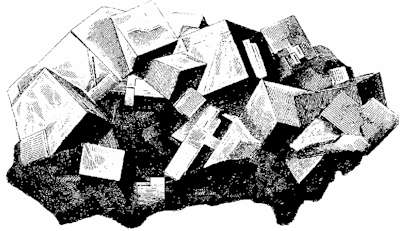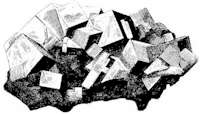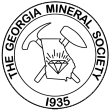Fluorite (CaF2)
by
Julian Gray, P.G.

Name: Latin: fluere, “to flow”, because it melts easier than other similar minerals (Blackburn and Dennen, 1997). Fluorine is named because it is a major constituent of fluorite (Mitchel, 1979).
Fluorite is also referred to as fluorspar. Spar is derived from an Old English word, spærstan, which translates to spar stone. Gypsum was the original spar. The term spar was later applied to any vitreous, crystalline, easily cleavable mineral. Other minerals are referred to as spars (Blackburn and Dennen, 1997).
| Calcspar | Calcite |
| Dogtooth spar | Calcite |
| Feldspar | Feldspar (German: feld = field, spat or spar = stone) |
| Fluorspar | Fluorite |
| Heavy spar | Barite |
| Iceland spar | Calcite |
| Pearl spar | Dolomite |
| Tabular spar | Wollastonite |
According to Fourestier (1999), spar refers to calcite or quartz. Fluorite has many synonyms and names in other languages: sparry fluor, fluor, fluor campacte, fluor cristallisatus, fluor cristallé, fluor granularis, fluor haloideo, fluor mineralis stolbergicus, fluor sodilus, fluor spathosus, fluor terreux (impure fluorite), fluor baryt, sparry fluor, spathfluor, spath fossile, and spath fusible (can used for barite and orthoclase).
Mineral Class:
Halide (Palache et al., 1951)
Crystallography:
Isometric, commonly found as cubic crystals {001}. Also occurs found as octahedra {111} or dodecahedra {011}. Penetration twins are common. Edges of cubic crystals are commonly modified by other crystal forms (Palache et al., 1951).
Physical properties:
Fluorite has perfect octahedral cleavage {111}. It has a hardness of 4, and has a very low specific gravity (G = 3.18). The refractive index of fluorite is 1.433. Fluorite is transparent to translucent and has a vitreous luster. It is found in a wide variety of colors, most commonly light green, yellow, bluish-green, or purple. Less commonly fluorite is colorless, white, rose, blue, or brown. The color in fluorite is usually due to the presence of hydrocarbons (petroleum) and the color is commonly banded. The color of fluorite may fade if heated. Some fluorite is thermoluminescent, meaning it will glow when heated (but you can only do this once, Robbins, 1994). It is occasionally fluoresces light blue in long wave ultraviolet light. In fact, the phenomenon we call fluorescence was coined by Professor George Stokes who first discovered this property in fluorite “I am inclined to coin a term and call it fluorescence from ‘fluor-spar, as the analogous term opalescence is derived from the name of a mineral” (Stoke as quoted in Robbins, 1994).
Chemistry:
Fluorite is a halide mineral consisting of 51.3 weight percent Ca and 48.7 weight percent F. Yttrium and cesium may substitute for calcium (Klein and Hurlbut, 1993). The yttrium and other trace impurities in fluorite are thought to be the activator causing fluoresces in fluorite (Robbins, 1994).
Occurrence:
Fluorite is a common mineral and is widely distributed. The most common occurrence of fluorite is as vein deposits, usually associated with lead and silver ores and with quartz, calcite, dolomite, and barite. It is found in cavities in sedimentary rocks, such as dolomite and limestone, where it is frequently associated with celesite, anhydrite, gypsum, dolomite, sulfur, and millerite. Fluorite is occurs in pneumatolytic deposits in greisens carrying cassiterite where fluorite may be associated with topaz, tourmaline, lepidolite, apatite, and quartz. At Wagon Wheel Gap, Colorado, fluorite is a major constituent of hot spring deposits. It is also found in miarolytic cavities in alpine environments and in pegmatites (rarely).
It has been suggested that the light-colored octahedral crystals indicate high temperature of formation. Darker cubic crystals are thought to have formed in lower temperature environments. Dodecahedrons form at intermediate conditions.
In the United States, significant fluorite deposits are found in southern Illinois (Rosclare and Cave-In-Rock). Optical grade fluorite was mined in Mercer and Woodford counties of central Kentucky. It is found in Cathage in Smith County, Tennessee. In pegmatites it is found at Amelia, Virginia and on Mount Antero, Colorado. It is found as clear cubes with celestite near Clay Center, Ohio.
Some of the most famous fluorite locations are in English and include Cumberland, Derbyshire (blue john, a light blue fibrous ornamental variety), and Cornwall. (Klein, 1993; Gaines et al., 1997; and Palache et al., 1951)
Uses:
Fluorite is used as a flux in steel making and in the manufacture of hydrofluoric acid (fluorite, water, and sulfuric acid combine to yield hydrofluoric acid and gypsum). Fluorite was once used for optical lenses, but these have been replaced by synthetic fluorite. It is used as a gemstone and for an ornamental stone (vases and dishes). It is also used in industry in the manufacture of glass, pottery, fiberglass, and enamel (Klein and Hurlbut, 1993).
References:
Blackburn, W.H., and Dennen, W.H., 1997, Encyclopedia of Mineral Names. The Canadian Mineralogist Special Publication 1, Mineralogical Association of Canada, 360 p.
de Fourestier, J., 1999, Glossary of Mineral Synonyms. The Canadian Mineralogist Special Publication 2, Mineralogical Association of Canada, 435 p.
Gaines, R.V., Skinner, C.W., Foord, E.E., Mason, B, and Rosenzweig, A., with sections by V.T. King, 1997. Dana’s new mineralogy - The system of mineralogy of James Dwight Dana and Edward Salisbury Dana: Eighth edition, entirely rewritten and greatly enlarged, John Wiley & Sons, New York, 1819 p.
Klein, C., and Hurlbut, C. S., 1993. Manual of Mineralogy (after J.D. Dana) 21st edition. John Wiley & Sons, Inc., New York, 681 p.
Mitchell, R.S., 1979, Mineral Names, What do they mean? Van Nostrand Reinhold, New York, 229 p.
Palache, C. Berman, H., and Frondel, C., 1951, The System of Mineralogy, Volume II, seventh edition: John Wiley & Sons, New York, 1124 p.
Robbins, M., 1994, Fluorescence: Gems and Minerals under Ultraviolet Light: Geoscience Press, Inc., Phoenix, Arizona, 374 p.
Roberts, W.L., Campbell, and Rapp. G.R., Jr., 1990, Encyclopedia of Minerals, Second Edition. Van Nostrand Reinhold, New York, 979 p.

Copyright © Georgia Mineral Society, Inc.
